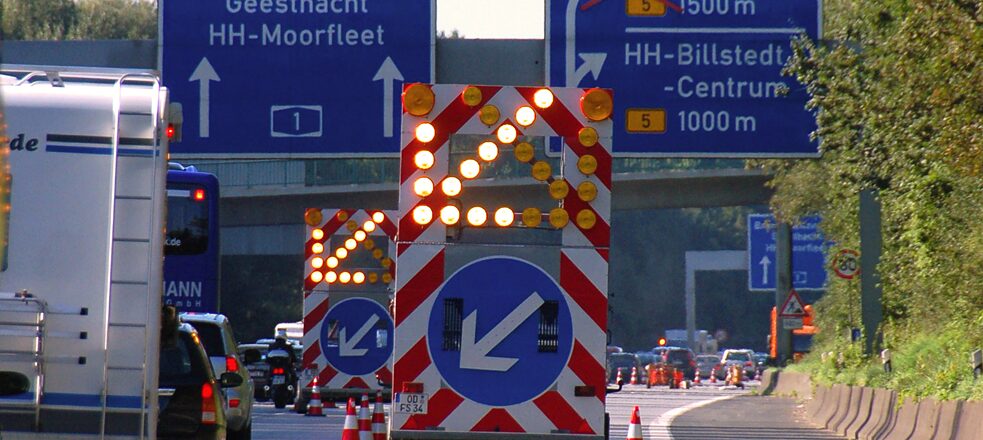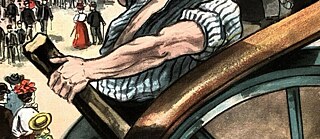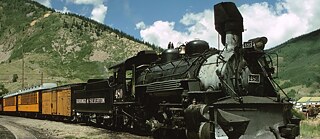Traffic
The Logic Behind the Traffic Jam
When asked to think of something every driver hates, most of us will immediately think of a traffic jam. But how do these annoying gridlocks occur? Along with construction zones, accidents, and bad weather, traffic pattern expert Michael Schreckenberg has identified us, the drivers, as the root of all evil.
Even scientists sometimes argue about what exactly constitutes a true traffic jam. Be that as it may, people perk their ears up immediately — generally in irritation — as soon as the word “jam” comes up in any context. At times, it generates fear and terror, even in the case of a “normal” paper jam in a printer. A jam is something that prevents something else from moving (forward), so it can lead to an absolute and forced standstill. No matter how you look at it, jams are always a time suck you would have preferred to avoid.
The German word for jam, “Stau,” originates from a completely different context in which the person involved in “stauen,” or “jamming,” was the perpetrator rather than the victim. The related verb “verstauen,” meaning to stow or stash something, entered common usage from 19th-century sailors who would jam cargo into the holds of their ships.
Today though, the jam is forced upon us. It almost seems to have an ephemeral life of its own — here one moment, gone the next. It frequently appears just when it is most inconvenient. And even worse, we often have no idea what has caused it at that very moment. Road work is not always the cause of traffic jams. It is often enough for just one driver to slow down abruptly — forcing everyone behind to join in. The resulting wave of braking is no longer a slowdown but a traffic jam.
| Photo (detail): © Adobe
These are called “phantom” or “ghost” traffic jams, though they are very real. How they occur has been a topic of hot debate among scientists. Now, based on huge amounts of data, mathematical models, and comprehensive computer simulations, traffic jam researchers have successfully gotten to the bottom of the phantom jam. Along with mathematics and physics, the psychology of drivers plays a decisive role.
Road work is not always the cause of traffic jams. It is often enough for just one driver to slow down abruptly — forcing everyone behind to join in. The resulting wave of braking is no longer a slowdown but a traffic jam.
| Photo (detail): © Adobe
These are called “phantom” or “ghost” traffic jams, though they are very real. How they occur has been a topic of hot debate among scientists. Now, based on huge amounts of data, mathematical models, and comprehensive computer simulations, traffic jam researchers have successfully gotten to the bottom of the phantom jam. Along with mathematics and physics, the psychology of drivers plays a decisive role.
Because a driver becomes a different person as soon as they climb into the driver’s seat. A change comes over all of us when we grab the steering wheel and press the gas pedal. There is a frequent sense of being at a disadvantage compared to others on the road, for example. Or to use the words of Danish philosopher Søren Kirkegaard, “Comparison is the end of happiness and the beginning of discontent.” And that is happening on the streets all the time.
Driving in a line of cars in a lane of the highway gives you plenty of time for observation. And it is easy to feel like more vehicles are overtaking you than you are managing to overtake. This is a simple psychological effect: The cars that have passed me are in front of me and so more memorable than the ones I have passed and left behind — out of sight, out of mind.
Furthermore, we are all anonymous in our vehicles; the other drivers on the road do not know who we are. This can lead us to do things we otherwise would not. Like selfishly refusing to make room in front of us in a “zipper merge.” This leads to tiny battles for mere inches that drive our blood pressure up. And in the end, the actions of those involved make traffic flow even slower than it would have been otherwise. It is like a funnel, regulating the inflow.
Unfortunately, drivers only think in one direction — forward. They simply do not notice what is happening behind them — not even the waves of braking cars that they are causing. This will (hopefully) change in the future, when automated or even fully autonomous vehicles are on the roads. The only question then is how they will get along with us human drivers.
The German word for jam, “Stau,” originates from a completely different context in which the person involved in “stauen,” or “jamming,” was the perpetrator rather than the victim. The related verb “verstauen,” meaning to stow or stash something, entered common usage from 19th-century sailors who would jam cargo into the holds of their ships.
Today though, the jam is forced upon us. It almost seems to have an ephemeral life of its own — here one moment, gone the next. It frequently appears just when it is most inconvenient. And even worse, we often have no idea what has caused it at that very moment.
It Appears out of Nowhere
There are a number of things that might cause congestion that we can directly identify. These include construction zones and accidents in particular but also bad weather like torrential downpours or fog or even the setting sun blinding drivers. But most traffic jams just appear out of nowhere. No visible reason, not even one you can identify when you finally emerge from the bottleneck. Road work is not always the cause of traffic jams. It is often enough for just one driver to slow down abruptly — forcing everyone behind to join in. The resulting wave of braking is no longer a slowdown but a traffic jam.
| Photo (detail): © Adobe
These are called “phantom” or “ghost” traffic jams, though they are very real. How they occur has been a topic of hot debate among scientists. Now, based on huge amounts of data, mathematical models, and comprehensive computer simulations, traffic jam researchers have successfully gotten to the bottom of the phantom jam. Along with mathematics and physics, the psychology of drivers plays a decisive role.
Road work is not always the cause of traffic jams. It is often enough for just one driver to slow down abruptly — forcing everyone behind to join in. The resulting wave of braking is no longer a slowdown but a traffic jam.
| Photo (detail): © Adobe
These are called “phantom” or “ghost” traffic jams, though they are very real. How they occur has been a topic of hot debate among scientists. Now, based on huge amounts of data, mathematical models, and comprehensive computer simulations, traffic jam researchers have successfully gotten to the bottom of the phantom jam. Along with mathematics and physics, the psychology of drivers plays a decisive role.Because a driver becomes a different person as soon as they climb into the driver’s seat. A change comes over all of us when we grab the steering wheel and press the gas pedal. There is a frequent sense of being at a disadvantage compared to others on the road, for example. Or to use the words of Danish philosopher Søren Kirkegaard, “Comparison is the end of happiness and the beginning of discontent.” And that is happening on the streets all the time.
Driving in a line of cars in a lane of the highway gives you plenty of time for observation. And it is easy to feel like more vehicles are overtaking you than you are managing to overtake. This is a simple psychological effect: The cars that have passed me are in front of me and so more memorable than the ones I have passed and left behind — out of sight, out of mind.
Furthermore, we are all anonymous in our vehicles; the other drivers on the road do not know who we are. This can lead us to do things we otherwise would not. Like selfishly refusing to make room in front of us in a “zipper merge.” This leads to tiny battles for mere inches that drive our blood pressure up. And in the end, the actions of those involved make traffic flow even slower than it would have been otherwise. It is like a funnel, regulating the inflow.
Drivers Only Think in One Direction — Forward
Back to phantom traffic jams. They follow their own dynamic as they develop, which results in a standstill for a short time. At places along the road where traffic density increases, such as interchanges and inclines, traffic initially starts to crawl at around ten to 30 kilometers per hour (approximately 19 miles per hour). Researchers also call this “synchronized” traffic flow because all lanes are moving at roughly the same speed. If just one person is not paying attention and has to tap the brakes a bit harder, it forces those behind them to slam on the brakes. Eventually, one car will have to stop completely, and all the cars downstream of it are forced to stop as well, at least briefly. A wave is created that flows back at about 15 kilometers per hour (approximately 9 miles per hour). And unfortunately, it is usually not just one traffic jam wave “driving” towards you either. Others follow, one after another. The congested areas act like pumps, which can be dangerous. A driver accelerating out of a traffic jam is feeling euphoric and thus less attentive when the next wave rolls in. This is how many accidents occur in traffic.Unfortunately, drivers only think in one direction — forward. They simply do not notice what is happening behind them — not even the waves of braking cars that they are causing. This will (hopefully) change in the future, when automated or even fully autonomous vehicles are on the roads. The only question then is how they will get along with us human drivers.






